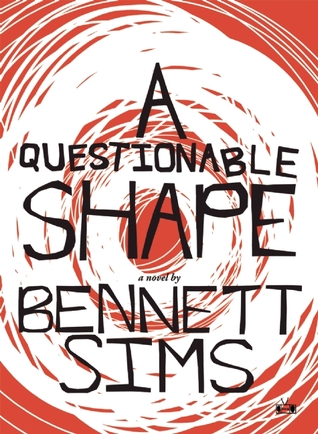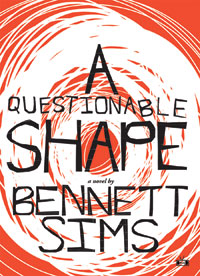The Doorknob Passage – A Conversation with Bennett Sims

I’ve never read a zombie novel, and after reading A Questionable Shape, the debut novel from Bennett Sims, which has been described as a zombie novel, I still haven’t. We see glimpses of rabid zombies on grainy mall security cameras, ghost-like versions in a field, and zombies crowding a police car, but the book is more about retracing our memories, how to deal with loss, and ultimately, how to live in a world falling apart around us. It’s a philosophical mind-fuck of a novel filled with illuminating sentences and dark footnotes.
Bennett and I traded emails to discuss his time as a student of David Foster Wallace, paranoia, insecurities, influences, and push-ups.
Shane: So, how are you feeling?
Bennett: It’s the end of the semester, so I’m feeling somewhat hollowed out. This year I was teaching an undergrad fiction workshop here at the University of Iowa, and I wrapped up all my grading yesterday. Nabokov has that line about finishing a work, how he feels like ‘a house just emptied of its grand piano.’ It’s a little like that—except that instead of producing beautiful music, the part of me that’s missing is used to shooting off workshop letters and miscellaneous correspondence. So I guess I’m feeling like a house just emptied of its fax machine, which is a different kind of quietness. How are you feeling?
Shane: I’m depressed because I’ve been doing nothing but eating cookies and drinking coffee and now I’m crashing from it. I’ve never heard of that Nabokov line before but I like it. Pale Fire is a beast and my favorite of his. Did Nabokov influence A Questionable Shape? I see some of his wordplay and magic in your sentences.
Bennett: Sorry to hear about the cookie-and-coffee comedown. I usually have to take a nap when that happens.
Thanks for the kind words about the book. I’m flattered by the Nabokov comparison. He’s definitely a background influence—one of the stylists I’ve admired longest, whose sense of wordplay and whose sheer felicity of description I’ve tried to absorb. But I was not thinking about any particular work of his when drafting A Questionable Shape. The footnotes, for instance, were self-consciously modeled on Nicholson Baker’s The Mezzanine, rather than Pale Fire.
A Questionable Shape by Bennett Sims
 A Questionable Shape
A Questionable Shape
by Bennett Sims
Two Dollar Radio, May 2013
242 pages / $16.50 Preorder from Amazon or Two-Dollar Radio
This ain’t your granddaddy’s zombie-apocalypse. Everything in Bennett Sims’s stunning debut courts a topographical and invasive examination of the human condition through our inverse. The architecture of zombie-logic is rewired, and the undead become symbolic for what it means to exist in all its physical and existential, its beauty and brutality.
Post-Katrina. Docile shapes fringe the horizon of greater Baton Rouge. Hurricane season looms yet again, threatening the security of Mississippi barges that quarantine thousands of zombies. If the barges breach, a second epidemic is likely. A Questionable Shape follows Vermaelen over one week as he helps his friend, Matt Mazoch, search for his undead father, retracing “haunts” Mr. Mazoch might return to in his zombified state. But hurricane season is also dwindling the window of opportunity to find him.
Sims escalates the psychological state of the undead, giving them, essentially, purpose. Reanimated, these zombies pursue places from memories. Reanimation, thus, becomes a kind Resuscitation. What the genre formerly defined as a vacant shell of rudimentary desire, Sims infuses with recollection, humanizing the traditionally dehumanized.
“What we know about the undead so far is this: they return to the familiar. They’ll wander to nostalgically charged sites from their former lives, and you can somewhat reliably find an undead in the same places you might have found it beforehand. Its house, its office, the bikelanes circling the lake, the bar. ‘Haunts.’ … In fact, what it calls to mind are those homing pigeons, the ones famous and fascinating for the particles of magnetite in their skulls: bits of mineral sensitive to electromagnetic pulls and capable of directing the pigeons, like the needle of a compass, homeward over vast and alien distances. It is as if the undead are capable of ‘homing’ in this way.”
“…our ‘walking dead’ don’t simply walk: anytime an undead is walking, what it’s really doing is remembering. It’s retracing steps from its former life and moving blindly along a vector of memory. In this way, the tracks that it leaves (of rainwater, of dirt across a carpet, of blood) record more than a physical path: they also materialize a line of thought, the path of that remembering.”
April 15th, 2013 / 12:00 pm
